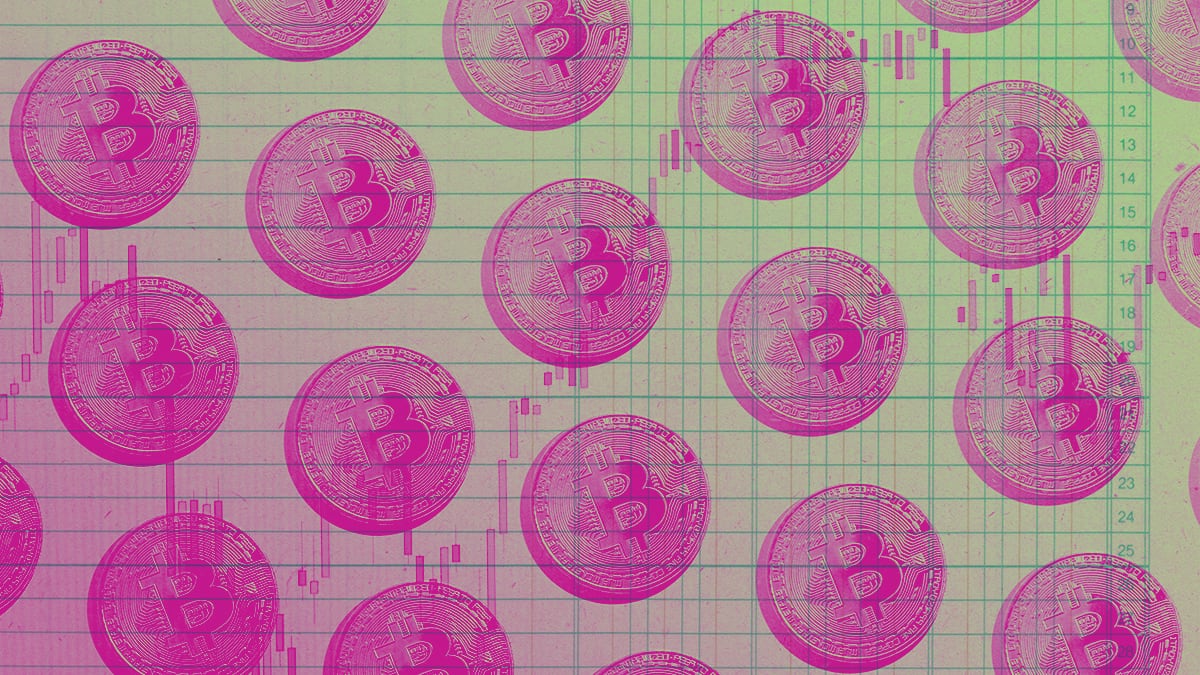This was supposed to be bitcoin’s moment to shine. Inflation is running wild, and Vladimir Putin is making not so veiled threats about nuclear war. A super-secure, super-rare digital currency was supposed to be the thing that would hold its value in the face of a twin shitstorm.
Instead, bitcoin has crashed, trading at $39,040 on March 8, down almost half from an all-time high of $69,000 in November. It looks more like the Russian ruble than a bar of gold.
So, is now the time to buy? If all the crypto bros loved bitcoin at nosebleed prices, should you like it now that it’s closer to earth? Will it start to behave the way its fans say it should during these troubled times and make you rich?
To answer that question, you have to know a few things about inflation, and about bitcoin.
Can Bitcoin Dodge Inflation?
First, inflation: It’s defined as a general increase in prices. Not just for beer or bok choy, but for everything. It often happens when there are too many dollars chasing too few goods.
That’s what’s happening now. The U.S. government wrote millions of checks to help people get through the pandemic. The Federal Reserve kept interest rates low to encourage people to borrow, and borrowing creates money (trust us on that one). To top it off, the stock market rallied, making the rich richer.
At the same time, supply chains got tangled, and it became impossible to get all the outdoor fire pits, cross-country skis, and huge TVs that we wanted, so people became willing to part with more of those abundant dollars to get them. Boom, inflation.
Now, bitcoin. Unlike the dollar and other “fiat” currencies, the number of bitcoins is limited to 21 million, once they are all unlocked by “miners” who get paid in new bitcoins to maintain the computerized ledger that keeps track of who owns how much of it.
Because no one can print huge numbers of bitcoins—like the U.S. government can with dollars—there should never be too many bitcoins chasing too few goods, so bitcoin should hold its value in the face of inflation. Instead, it has been falling.
So What Went Wrong?
Brandon Wooters, a financial adviser at Edward Jones, says to avoid bitcoin and other cryptocurrencies, no matter what the price.
“My clients aren’t in this for the roller-coaster ride,” Wooters says.
There aren’t any sales or earnings, like with stocks, or interest payments, like with bonds, to help investors estimate the value of bitcoin, Wooters says. “The price of bitcoin is determined only by what people are willing to pay for it.”
And, while there are only ever going to be 21 million bitcoins in existence, there are dozens of other cryptocoins—ethereum, avalanche, cardano, solana, polkadot, monero, TRON, dogecoin (created as a joke)—with more being minted every day. Talk about inflation.
“If you have Paris Hilton issuing her own crypto product then the whole concept of limited issuance is out the window,” says Chris Abbruzzese, co-founder of Rain Capital Management.
Earlier this year, Hilton issued a series of non-fungible tokens, pieces of digital art whose uniqueness is guaranteed by a blockchain, the technology underpinning cryptocurrencies. NFTs are the web’s answer to collecting baseball cards. They appeal to the same people buying bitcoin, further swamping the crypto bazaar.
If Not Bitcoin, Then What?
So what is an investor to do about inflation? You’ve got to do something, because if inflation is running at 7.5%, then that $1,000 you have stashed in your mattress is losing $75 a year in terms of what you can buy with it.
Both Wooters and Abbruzzese suggest something much less exotic: stocks. And not sexy, money-losing tech stocks. You need companies that churn out reliable sales and earnings.
Inflation is a vicious cycle. Prices go up, so workers demand higher wages to make ends meet. They spend the increase on more goods, prices go higher, and so on. Moneymaking companies can raise the prices of their products when the cost of labor rises, preserving profit.
“Stocks have built-in inflation protection,” Wooters says.
So, how do you find moneymaking stocks? There are lots of them clustered in index funds focused on “value.” On Wall Street, a value stock is one that hasn’t soared into the stratosphere because people think it’s going to be the next Google.
For example, an exchange-traded fund called the SPDR Portfolio S&P 500 Value ETF (symbol: SPYV) owns companies like Johnson & Johnson, Exxon Mobil, and Walt Disney. Each might be evil in its own way, but all of them produce relatively reliable sales and earnings.
Other funds avoid oil and gas but retain inflation protection by holding big, established names. The SPDR S&P 500 Fossil Fuel Reserves Free ETF (symbol: SPYX) owns companies like Apple, Microsoft, Alphabet, Amazon, and Berkshire Hathaway, which have pricing power and churn out consistent earnings.
Still bitcoin curious? Mike Zaccardi, an investment writer who contributes to a no-nonsense site called HumbleDollar, says it makes sense to put a tiny portion of your nest egg into crypto, just in case crypto boosters are right and it is the future of money.
“At 1 or 2 percent of your portfolio, you’re not going to lose your shirt,” Zaccardi says.
See More of A Portlander’s Guide to Surviving Inflation Here!
